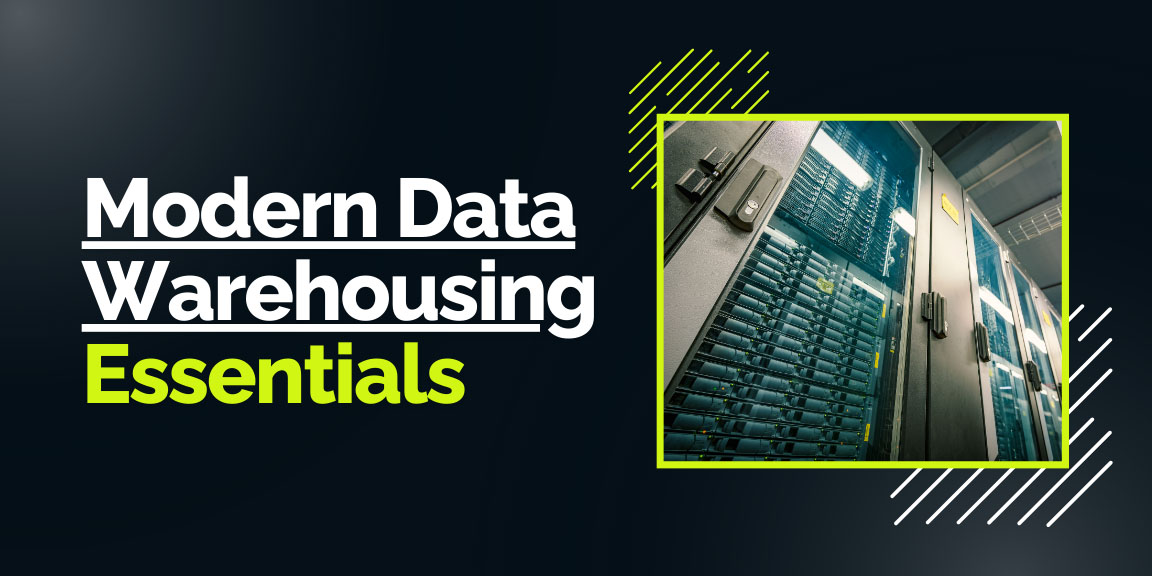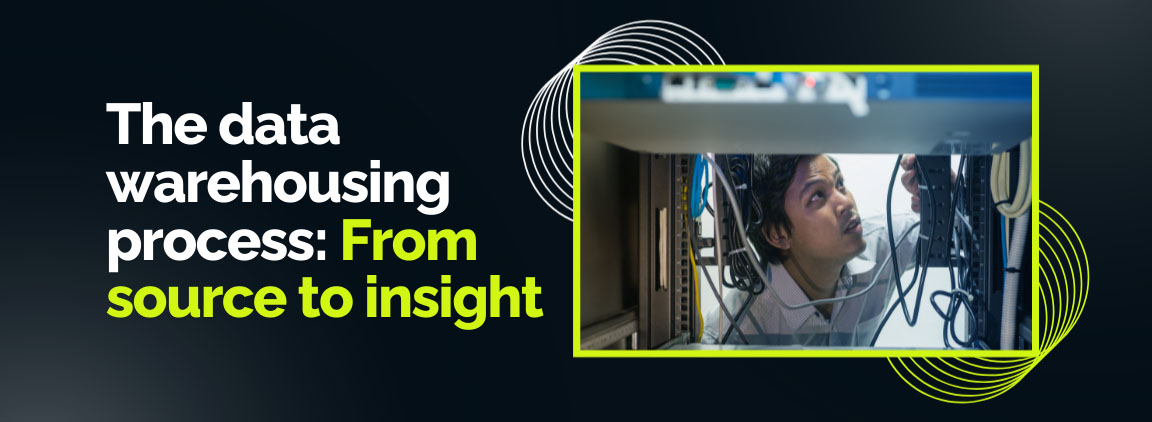Digital Transformation, zBlog
Data Warehousing – Definition, Types, Process, Use Cases, Components
atif | Updated: January 6, 2026

Across industries, leaders are asking the same questions: Can we trust our data? Why do different reports show different numbers? How do we make AI useful without creating chaos or risk? A well‑designed data warehouse gives a calm, confident answer to these questions by providing a single, governed place where business data lives, evolves, and tells a consistent story.
For us at Trantor, data warehousing is not just a piece of technology—it is part of a broader data strategy that connects people, processes, and platforms. In this guide, we walk through the fundamentals and the modern realities of data warehousing so you can make informed decisions, whether you are designing your first solution or modernizing a legacy one.
What is data warehousing?
Imagine your organization’s data as being scattered across hundreds of “rooms”: CRM, ERP, finance tools, marketing platforms, support systems, and SaaS apps. Each room keeps its own records, formats, and rules; no wonder it takes days to answer a seemingly simple question like “How many new customers did we acquire last quarter?”
A data warehouse acts as a carefully designed central hall where all this information is brought together, cleaned, and arranged so everyone can see the same, reliable view of the business. Instead of analysts spending most of their time searching for data and reconciling conflicting numbers, they can focus on asking better questions and finding better answers.
Formal definition and core characteristics
From a more technical perspective, we can define data warehousing as:
The integrated process of collecting data from multiple sources, transforming it into a consistent structure, and storing it in a centralized repository—called a data warehouse—designed specifically to support analytics, reporting, and advanced decision‑making.
Classic data warehousing theory describes four key characteristics, which remain surprisingly relevant in 2026:
- Subject‑oriented — Data is organized around business subjects such as sales, finance, customers, or operations, rather than around individual applications.
- Integrated — Data from different systems is cleaned, standardized, and reconciled so definitions and formats match across the warehouse.
- Time‑variant — The warehouse stores historical data over long periods, making it possible to analyze trends, compare time periods, and build predictive models.
- Non‑volatile — Once data is loaded, it is rarely changed or deleted; new data is added over time, preserving a reliable history for analysis.
How a data warehouse differs from databases and data lakes

Many teams feel confused because they already have databases and maybe even a data lake. Clarifying these differences helps everyone see where a warehouse truly adds value.
- Operational databases: Focus on day‑to‑day transactions: creating orders, updating customer records, processing payments. Optimized for fast writes and lookups, not for scanning millions of rows across years of history.
- Data warehouses: Focus on analytics and decision‑making: answering questions, spotting patterns, building dashboards. Optimized for read‑heavy, aggregated queries and complex joins, often using columnar storage and dimensional modelling.
- Data lakes: Store raw, often unstructured data (logs, events, files, documents) at scale, typically in cheap object storage. Excellent for data science and experimentation, but without modelling and governance they can become “data swamps.”
Increasingly, organizations are adopting lakehouse architectures, which bring the governance and performance of a data warehouse into a data lake environment, enabling both BI and advanced analytics on a common foundation.
Why organizations still invest in data warehousing

From data chaos to trustworthy decisions
The biggest benefit of a data warehouse is psychological as much as technical: leadership can finally look at a dashboard and feel confident that everyone is working from the same numbers. When sales, finance, and operations all rely on the same governed data sets, discussions shift from “whose report is right?” to “what should we do next?”
For mid‑to‑large enterprises, this shared confidence directly translates into faster decisions, less friction, and a stronger ability to respond to market shifts.
Enabling AI, analytics, and personalization
Modern AI and machine learning models require rich, high‑quality historical data to learn from. A robust data warehouse provides curated, feature‑ready datasets that data scientists and ML engineers can trust, dramatically reducing the time they spend cleaning and reconciling data.
At the same time, digital teams can plug into the warehouse to personalize customer experiences across web, mobile, and contact center channels—without each team reinventing its own data pipeline.
Supporting compliance and governance
Industries such as healthcare, banking, insurance, and retail are under constant regulatory scrutiny. Data warehouses play a crucial role in:
- Maintaining auditable histories of key transactions.
- Enforcing retention policies and lawful data use.
- Providing consistent numbers for statutory and regulatory reporting.
When governance is built into the data warehousing process—from ingestion to access—organizations reduce risk and build trust with regulators, customers, and partners.
Types of data warehouses

Different organizations need different flavours of data warehousing, depending on their size, complexity, regulatory environment, and existing technology stack. Understanding the main types makes it easier to choose the right path rather than forcing a one‑size‑fits‑all approach.
By functional scope
- Enterprise Data Warehouse (EDW): A centralized warehouse that integrates data across the whole enterprise—sales, marketing, finance, HR, supply chain, and more. Provides a single source of truth and a common semantic layer for all analytics. Typically governed by a central data team with strong data stewardship in each domain.
- Operational Data Store (ODS): A near‑real‑time store of operational data from transactional systems. Designed to support current‑state reporting and operational dashboards, not long‑term history. Often acts as an intermediate layer feeding the main warehouse or downstream applications.
- Data Mart: A subject‑specific slice of data, focused on a particular function like sales, marketing, or finance. Can be physically separate or logically defined within a larger EDW. Useful when a department needs faster delivery or tailored structures without waiting for entire‑enterprise models to stabilize.
- Real‑time or active data warehouse: Built to ingest and expose data with minimal latency. Often combines streaming tools and micro‑batch ingestion with specialized indexes or materialized views. Suitable for scenarios such as fraud detection, inventory monitoring, or personalised offers.
By deployment model
- On‑premises data warehouse: Runs in the organization’s own data center on physical or virtual servers. Allows full control over hardware and security, but demands higher upfront and maintenance costs. Common in industries with strict data residency rules or heavy legacy investments.
- Cloud data warehouse: Fully or largely managed warehouses offered by providers such as Snowflake, Amazon Redshift, Google BigQuery, and Azure Synapse. Provide elastic compute and storage, usage‑based pricing, and rapid provisioning. Ideal for organizations looking to scale analytics quickly without managing hardware.
- Hybrid data warehouse: Combines on‑premise and cloud environments, often during a multi‑year modernization journey. Data may be replicated or federated across both environments with secure connectivity. Useful when some workloads must remain on‑premise while others move to the cloud.
- Virtual or federated data warehouse: Offers a logical view across multiple data sources without fully copying data into a single physical store. Relies on data virtualization techniques, caching, and query optimization. Works best when latency and source system performance can be managed carefully.
- Lakehouse and big‑data warehouse: Blends data lake storage (for raw, semi‑structured data) with data warehouse performance and governance. Enabled by platforms like Databricks, Snowflake, and BigQuery using open formats and unified governance. Provides a scalable foundation for both traditional BI and advanced AI workloads.
Key components of a modern data warehousing solution

A robust data warehouse is more than just a big database. It is a coordinated system of components that manage data from ingestion to insight.
1. Data sources
These are the systems and platforms where data is originally created, including:
- Operational applications (CRM, ERP, HR, finance, POS).
- SaaS platforms (marketing automation, customer support, e‑commerce).
- Machine and IoT data (sensors, devices, logs).
- External data (market feeds, demographic data, open datasets).
Good warehousing design starts with a clear inventory of sources and a shared understanding of which systems are “systems of record” for each data domain.
2. Data ingestion and integration (ETL / ELT)
This layer moves and prepares data for the warehouse. Common patterns include:
- ETL (Extract–Transform–Load): Data is extracted from sources, transformed using integration tools, and then loaded into the warehouse. Suits on‑premise architectures and situations where transformations must happen before data reaches the main store.
- ELT (Extract–Load–Transform): Data is quickly loaded into the warehouse in near‑raw form and transformed there using the warehouse’s compute power. Popular in cloud environments where scalability and separation of storage/compute are strong advantages.
Modern stacks often combine batch and streaming ingestion, using tools such as Kafka, Kinesis, or cloud‑native streaming services for real‑time feeds.
3. Central data warehouse storage
This is where integrated, modelled data lives. Key design choices include:
- Schema design — Star and snowflake schemas with fact and dimension tables remain widely used for BI workloads.
- Storage format — Columnar storage and compressed formats dramatically improve performance and reduce costs.
- Partitioning and clustering — Splitting data by date, region, or other keys to speed up queries and data lifecycle management.
In many modern environments, the same logical warehouse may span different physical stores (for example, structured tables for core facts and dimensions plus open‑table formats for large‑scale or semi‑structured data).
4. Metadata, catalog, and semantic layer
Metadata is the connective tissue that helps people trust and find data. Robust warehouses maintain:
- Technical metadata — Table structures, data types, lineage, and transformations.
- Business metadata — KPI definitions, owners, and business rules.
- Semantic layer — A curated layer where business users interact with friendly terms like “Net Revenue” rather than raw table names.
A searchable data catalog with clear ownership and documentation is key to enabling self‑service analytics without overwhelming central teams.
5. Analytics, BI, and access tools
This is the visible part of the warehouse for most users:
- BI dashboards and reports in tools like Power BI, Tableau, Looker, or embedded portals.
- SQL and notebook access for data analysts and data scientists.
- APIs and data services that feed downstream applications and machine learning workflows.
Carefully designed role‑based access control ensures that users see only what they are allowed to see, while still keeping the experience smooth and productive.
6. Data governance, quality, and security
Without governance, the most sophisticated warehouse quickly turns into another silo. Effective governance includes:
- Data stewardship and ownership for each domain.
- Data quality management — profiling, anomaly detection, and remediation workflows.
- Security controls — encryption, access policies, tokenization, and masking where needed.
- Compliance alignment — ensuring retention, consent, and usage policies are respected.
Data observability—a relatively new discipline—helps teams automatically detect broken pipelines, schema changes, and freshness issues before business users are impacted.
The data warehousing process: From source to insight

Although every organization’s implementation is unique, successful data warehousing initiatives follow a broadly similar lifecycle.
Step 1: Strategy and requirements
Before choosing tools or designing schemas, we start with foundational questions:
- What decisions need better data support (for example, pricing, inventory, customer retention)?
- Who will use the warehouse—executives, analysts, data scientists, operational teams?
- Which KPIs and metrics are non‑negotiable for the business?
Capturing these requirements helps ensure the warehouse is built to solve real problems rather than becoming a technology project in search of a purpose.
Step 2: Data modelling and architecture design
Next comes the design of the warehouse itself:
- Choosing between centralized, hub‑and‑spoke, or data‑mesh‑aligned architectures.
- Defining conformed dimensions (like customer, product, time) that can be reused across domains.
- Selecting storage technologies and deciding how the warehouse will interface with lakes, marts, and operational systems.
The goal is to strike a balance between flexibility and governance. Over‑engineering early can slow delivery, while under‑engineering can invite chaos later.
Step 3: Building ingestion and transformation pipelines
With design in place, technical teams build pipelines to move and transform data:
- Initial full loads of historical data.
- Incremental loads capturing only new or changed records.
- Slowly changing dimensions to track how master data evolves over time.
Automated testing and monitoring at this stage prevent bad data from flowing silently into dashboards and board meetings.
Step 4: Implementing access, analytics, and self‑service
Once reliable data is available, attention shifts to how people will actually use it:
- Curated data models and views for different business personas.
- Dashboards and standard reports for recurring needs.
- Governance‑friendly self‑service capabilities so users can explore data safely.
Training and change management are just as important as the technical delivery; if people do not know how or why to use the warehouse, adoption will lag.
Step 5: Ongoing operations, optimization, and evolution
Data warehousing is not a “launch and forget” project. Over time, teams need to:
- Add new data sources and subject areas.
- Optimise performance and costs (especially in the cloud).
- Update models as the business changes—new product lines, acquisitions, reorganizations.
A mature warehouse becomes a living product, managed with agile and DevOps (or DataOps) practices, rather than a static IT asset.
Real‑world use cases for data warehousing

Data warehousing shows its true value when we look at concrete business problems it helps solve.
1. Customer 360 and personalized experiences
Retailers, banks, and subscription businesses often hold fragments of customer behaviour in many systems. A data warehouse integrates transactions, interactions, demographics, and digital signals into a unified view, enabling:
- Segmentation for targeted campaigns.
- Recommendation engines and personalized offers.
- Early detection of churn risk.
2. Financial and regulatory reporting
Finance teams rely on accurate, reconciled data from multiple ledgers, billing platforms, and operational systems. Warehousing solutions provide:
- Consolidated financial statements and profitability analysis.
- Audit trails for every key metric.
- Faster, more consistent regulatory reporting (for example, in BFSI and insurance).
3. Supply chain and operations optimization
Manufacturers, logistics companies, and retailers use warehouses to combine data from inventory systems, procurement, production, and transportation. This enables:
- Inventory optimization and demand forecasting.
- Supplier performance analysis.
- Root‑cause analysis for delays and cost overruns.
4. Healthcare quality and outcomes
Healthcare providers and payers often face strict privacy rules alongside the need for broad analytics. A well‑governed data warehouse can:
- Bring together clinical, operational, and claims data.
- Support quality reporting and outcome tracking.
- Enable population health analytics while respecting privacy and consent.
5. Digital product and marketing performance
Digital‑first organizations track vast amounts of behavioural data from websites, mobile apps, and campaigns. Data warehouses make it possible to:
- Attribute conversions across channels.
- Understand user journeys and drop‑off points.
- Optimize acquisition cost and lifetime value over time.
Best practices for successful data warehousing in 2026

Start with business outcomes, not tools
The most successful data warehousing initiatives are anchored in clear business outcomes—such as reducing reporting time, improving forecast accuracy, or enabling new revenue streams—rather than in tool selections. Defining these outcomes upfront helps prioritize features and keep the project grounded when technical complexity arises.
Design for change, not perfection
Business structures, products, and regulations evolve constantly. Instead of chasing a perfect model on day one, design your warehouse to evolve:
- Deliver value incrementally with a small number of high‑impact subject areas first.
- Use modular, loosely coupled data pipelines.
- Maintain versioned models and clear deprecation paths for old ones.
Invest in governance and literacy
Governance is not just about restricting access; it is about clarity and shared understanding. Invest in:
- Data stewards for key domains.
- A business glossary and data catalog.
- Training programs that build basic data literacy across the organization.
When people understand both what the data means and how they are allowed to use it, adoption grows organically.
Use cloud and automation wisely
Cloud platforms have dramatically lowered the barrier to entry for sophisticated data warehousing. At the same time, costs can creep up quickly without governance. Good practice includes:
- Right‑sizing compute and scheduling non‑urgent workloads off‑peak.
- Automating infrastructure with infrastructure‑as‑code, CI/CD, and DataOps pipelines.
- Using observability tools to monitor data quality and pipeline health.
Treat the warehouse as a product
Thinking of the warehouse as a product—with a roadmap, backlog, user feedback, and continuous improvement—shifts the culture from “project completed” to “capability evolving.” Cross‑functional teams combining data engineers, analysts, product owners, and business stakeholders tend to deliver the most sustainable outcomes.
Frequently asked questions about data warehousing
1. What is a data warehouse in simple terms?
A data warehouse is a central, organized store of business data that brings together information from many systems so it can be analysed consistently and reliably. Instead of hunting through multiple databases and spreadsheets, teams use the warehouse as their shared reference point for decisions.
2. How is data warehousing different from databases or data lakes?
Operational databases focus on processing transactions quickly—like saving an order or updating a customer record. Data warehouses are built for analysis, storing large amounts of historical and integrated data to answer business questions, while data lakes keep raw, often unstructured data at scale for exploration and data science.
3. What are the main components of a data warehouse?
Typical components include data sources, ingestion and integration pipelines (ETL or ELT), a central warehouse storage layer, metadata and catalog, analytics/BI tools, and governance and security controls. Together, they move data from creation to insight in a controlled, repeatable way.
4. Who should own the data warehouse in an organization?
Ownership is usually shared: a central data or analytics team manages the platform, while business domains (like finance or marketing) own the meaning, quality, and correct use of their data. A clear framework for data stewardship and decision‑making helps avoid gaps and conflicts.
5. How long does it take to implement a data warehouse?
Timelines vary widely depending on scope, complexity, and existing infrastructure. Many organizations start with a focused use case and deliver value in a few months, then expand incrementally rather than waiting for a multi‑year, “big bang” rollout.
6. Are data warehouses still relevant in the age of AI and lakehouses?
Yes—if anything, they are more important than ever. Modern warehouses may look different, integrating tightly with data lakes and lakehouse platforms, but the core goal remains the same: providing trustworthy, governed data for analytics, AI, and decision‑making.
7. How does Trantor approach data warehousing projects?
Trantor typically starts with a discovery phase to understand your current data landscape, pain points, and desired outcomes. From there, we co‑create a roadmap that may include modernizing an existing warehouse, designing a new cloud or hybrid architecture, or building out specific use cases such as customer 360 or financial reporting.
Conclusion
Data warehousing has evolved from a back‑office reporting tool into a strategic capability that underpins analytics, AI, and digital transformation. By understanding key concepts—definition, types, components, and process—and by grounding your approach in real business outcomes, your organization can move beyond fragmented data and build a more confident, data‑driven culture.
At Trantor, we bring together deep technical experience with a practical understanding of how businesses actually use data—from boardroom dashboards to frontline applications. Whether you are designing your first warehouse, modernizing to a cloud or lakehouse architecture, or looking to embed advanced analytics and machine learning into your operations, we are ready to partner with you on the journey. Learn more about how we can support your data warehousing and analytics initiatives at Trantor.




